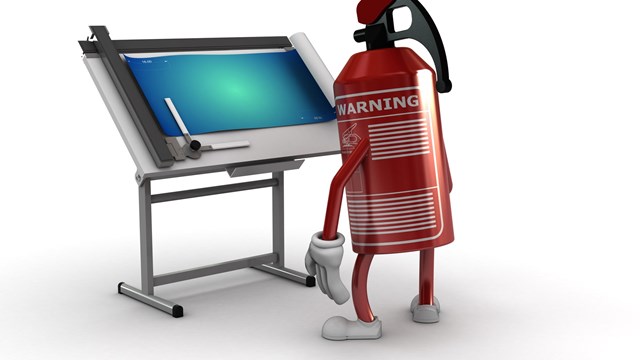The chance of experiencing a fire in your residential property is almost as unlikely as experiencing a plane crash—it’s a miniscule number of incidents that affect a tiny percentage of the population [see sidebar on page 14]. But fire-related tragedies are almost all preventable, and just like airline officials, fire fighting professionals are committed to bringing that statistic down to zero.
And with high-tech detection systems and increasing use of sprinklers, industry experts report that property damage and human injury and fatalities from fire have decreased steadily in recent decades.
Building and fire codes cannot save anyone from careless behavior, however. In condominiums and multi-family residences, the most common causes ofaccidental fires are candles, cigarettes and gas grills on decks or balconies.
Human behavior is where fire officialsbegin when considering fire safety. People make mistakes with gas grills, heaters and fireplaces that can result in fires or explosions.
As Brent MacAloney, fire chief in Westminster, Massachusetts, illustrates, “I’ve seen occasions where a homeowner is trying to get [a gas heater or burner] to ignite, and in the process is filling the interior space with gas… Then the furnace automatically kicks in and ignites… it can set off the whole house.”
For most homeowners, he says, fire safety awareness should start with basic maintenance of everyday appliances. “There are some things that people need to be astute about,” MacAloney states, “Anobvious [potential hazard] is in clothes dryers,” where lint can build up and ignite. Beyond emptying the lint filter with each use, he notes that dust and lint can settle inside a dryer, in corners, the bottom pan and around the vent hose—all these hidden areas need an occasional check-up and clean-out.
And it’s not just dryers that have dust collecting in the bottom. “When you hear squeaks or noises while operating any household appliance with a motor, such as clothes or dish washers,” warns MacAloney, “it means belts or bearingsare worn out, causing friction and heat… then sparks from the motor can start a fire.” He cites a condo fire in his town recently that ignited in the bathroom ceiling fan.
The exact cause—difficult to pinpoint—may have been defects in the motor or wiring, but it brought up another issue. When any product, tool or appliance catches fire like that, MacAloney advises, “Always save the [burned] item, or the parts.” The insurance company, and consequently the manufacturer, may be very interested in this evidence.
He points out that all kinds of appliances are regularly recalled by manufacturers, often for posing a fire hazard, and many consumers don’t getthe message. The risk of missing a recall warning is especially apparent when purchasing household items at flea markets--or online.
“You can check [items] on a website provided by the Consumer Product Safety Commission,” he states, “you justhave to type in the model number… to see if it has been recalled.”
Products are recalled for safety reasonson a surprisingly regular basis, says MacAloney, adding, “I’ve personally had four different products recalled—that I know about—and I’m just an average consumer.”
How do fire codes help?
Ronald DeBlois of DeBlois Risk Services in Hollis, New Hampshire, does consulting for insurance companies, developers and fire departments, primarily in Massachu-settsand New Hampshire. The level of fire protection often revolves around fire safety codes, he notes, “and [these] vary from state to state… plus, towns can have their own ordinances which are stricter…. You have to know the codes for where the property is located.
“If a building conforms to all fire code requirements, the resistance [to a fire event] increases,” he adds. The building codes are meant to keep a fire from spreading, and even simple repairs or retrofits can go a long way toward stemming the spread of flames. For instance, he says, “Holes in floors or walls for heating pipes should be caulked… as a fire-stop.”
“In new construction,” continues DeBlois, “sprinkler systems in multi-family housing are required almost everywhere [throughout New England], but remember that [multi-family] is defined as more than three units per building.”
Kurt Ruchala, director of engineering at Fire Pro, Inc., located in Andover, Massachusetts, a fire protection engineering firm, designs alarm and sprinkler systems and conducts fire code studies for developers, building owners and municipalities. He reports that “fires are down in general from where they were 20 years ago [although] the alarm rate is up because of [more prevalent] detection systems.”
Ruchala notes that in multi-family and condominium communities, fire/building codes usually ensure that “fire walls or barriers are constructed between [residential] units,” and that common areas conform to widely accepted standards such as clearly-marked exits, unobstructed doors that open outward and having fire extinguishers.
The challenge for his firm, he says, is that “there are different fire codes with different levels of protection, based on sizes of buildings and the number of stories they contain.”
Given the fact that building and fire codes can vary from one town to another, this means that association boards and managers need to ascertain what the law actually requires [to meet fire codes] within their own property and whether their community conforms to these requirements. Boards should take the next step and determine whatemergency protocols may be advisable beyond what the law requires.
Ruchala concurs that fire codes are intended to keep flames contained in afire incident, and that “getting people out” and personal safety need to be addressed separately.
Building and fire codes are not what ultimately save lives, he points out. “Residents should have an understanding of the safety protection within their own buildings. There should be afire safety plan [that spells out] where to go and how to behave. People need to understand what to do when fire systems activate.”
It’s also important to note that flame resistance has not increased with modern technology. While institutions such as schools and hospitals may conform to flame-retardant rules or guidelines for interior furnishings, there are no similarregulations for private residences.
So, while homes of 100 years ago had plenty of natural materials that were flammable, modern homes are filled with synthetics that are even more flammable. “Furniture today burns hotter and faster than ever before,” notes Ruchala. Even building materials are more flammable, he adds. The wood composites that make up trussesand beams will burn up faster than an old-fashioned solid wood beam will.
Other hazards may trump fire in an emergency plan
Bo Mitchell, president of 911 Con-sulting, LLC, in Wilton, Connecticut, notes that “fire is way down on the list” of hazards that housing managers should be ready for. “All kinds of things can trigger an emergency response… Fire is one of about 20 major response events. An all-hazards plan is more important than a fire protection plan.”
He cites the National Fire Protection Association (NFPA) as a comprehensivesource and reference. “The NFPA has been around since 1896… You can review about 1,000 standards [in their publication ‘NFPA 1600’] for alarms and everything else in an emergency preparedness plan.”
Since most condominium communities do not have fire/emergency drills, he says, it’s up to a property manager or building superintendent to communicate evacuation routes and safety procedures to all residents. It’s also essential for management or maintenance staff to check emergency warning systems and alarms, or detectors, according to prescribed schedules.
Association boards have to decide how much of a protective role they wish to take on. Mitchell asks, “Shouldyou consider installing a panic button by the treadmill in the fitness center?” There are other threats from which residents may expect protection. “Is it the board’s responsibility to warn residents if there’s a restraining order out on someone in the community?”
With any residential property, he states, “a condo board, like a building owner, is a responsible party and can be held liable… But what are they responsible for? It can be a real grey area.” He warns that “a medical emergency is far more likely [than a fire]… even in common areas. Does your on-site manager or security guardhave emergency procedures down pat? Beyond that, rescue personnel should know how to get to any unit, or common space, without delay.”
The real issue for communities is to look at fire safety as part of a comprehensive emergency plan. Condominiumboards or the management staff must lay out a protocol—a response to any likely emergency—and make sure it’s communicated to all residents.
Marie N. Auger is a freelance writer in Westminster, Massachusetts, and a regular contributor to New England Condominium magazine.







Leave a Comment